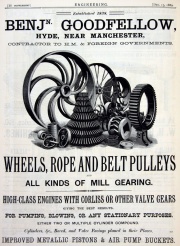Grand Re-Opening Wellington Wheel Pit, March 2012
In 1794 the Mellor Mill, Bottoms Mill was opened, six stories, 400feet long, and 33 feet wide the mill was powered by the Wellington Wheel. A breast water wheel 22 feet diameter, 18 feet wide. Power was transferred, from the edge of the wheel to the rest of the mill by vertical shafts. By 1804, 10,080 spindles were operating and up to 550 workers (mainly women and children) were employed. However less than fifteen years later the need arose for a second wheel, and the Waterloo Wheel, was constructed. And in 1860 investement was made in the new form of power, steam, the steam and boiler house.
The following video covers the re-opening of the Wellington Wheel Pit to the public in March 2012, the wheel itself long gone. (Chris Mann, of Manmade productions, produced the video)
The Mellor Mill site was moribund for the next near century and a quarter, following the disastrous fire of 1892. The brickwork broke down into clay, leaf mould into soil, and trees grew, and grew as this time passed until the Mellor Archaeological Trust came along, with the novel idea of emptying the Wellington Wheel Pit. This endeavour was helped by a £15,000 grant from The Association of Industrial Archaeology, together with £5,000 from the Trust. Plans were to open up the Pit, put up interpretation boards, and open the whole area to the public; this was achieved and celebrated in a grand opening in March 2012. Excavation of the pit had started in June 2011, initially with a 22 ton digger, then in tandem with Bob’s own 1 ½ ton digger in the pit itself, lowered by its bigger brother. Work has continued, almost every week-end and some week days. Volunteers have uncovered the cobbled area in front of the mill, the 20 metre tunnel that took the drive shaft away from the Wellington Wheel, as well as stable for visitor’s horses, under the front projection.
- Details
- Category: Mill Videos
- Hits: 14359
Featured Article: Steam Engine & Boiler House
Steam Power came comparatively late to Mellor Mill, in comparison with a majority of large cotton mills. Quarry Bank Mill built in 1784, had Boulton & Watt steam engines in 1810, however the nearby Torr Vale Mill had itself survived until 1856, when being re-built, without a steam engine.
In 1860 two steam engines and boilers were installed by Benjamin Goodfellow, well-known Hyde engineer. Goodfellow supplied the engines to power the London sewage system in 1895, replacing those of James Watt & Co.
Boilers and engines were enclosed in a new building at the northern end of the main mill building. The installation of the event was of such note that, following a successful trial run of the system, the company saw fit to have an evening celebration dinner at the Navigation Inn.
The following video was produced by Chris Mann of Manmade Productions,who has made several videos for MAT,and features Bob Humphrey-Taylor, Rachel Miller, our volunteer archaeologist, and Dr. John Glithero.
From the Stockport Advertiser 14th. September 1860
Marple News
On Friday evening last, a very liberal repast was prepared at the house of Mr. George Swain, The Navigation Inn, Marple, for the managers the overlookers, and a number of employés belonging to the cotton-spinning establishment of Peter Arkwright, Esq of Mellor, on the occasion of the erection of two new engines, boilers and large chimney, on the premises. It is somewhat remarkable that this model factory has been turned by a large and well-constructed water wheel, supplied by an extensive reservoir on the premises, and from the River Goyt. Owing, however, to the drought that has prevailed for the last two or three years, that vast spinning establishment could not be carried on so regularly and as heretofore, and hence the necessary for providing additional moving power, which has now been successfully and satisfactorily completed by and under the direction of, Mr. Benjamin Goodfellow, of Hyde. On testing the engines which gave unqualified satisfaction, the above mentioned “spread”, was given, which reflected much credit upon the caterers. After the cloth was down, Mr. Wheeldon, the manager was called upon to preside, when the songs, toasts, recitals’ followed each other, and the evening passed most pleasantly –Miss Swain presiding at the piano-forte, and singing several favourite songs, and joining in with her brother, Master Charles Swain, in some choice duels.
Source: Stockport Advertiser
14th Sept 1860:P.2 Col.7
sources:
Goodfellow London Sewage pump 1895
Grace's Guide: Benjamin Goodfellow
- Details
- Category: Mill Videos
- Hits: 15205
A couple of videos taken earlier this year, by Bob Humphrey-Taylor.
The early days of the excavation of the Steam Engine and Boiler House House area are the subject of the first film, whilst the season's subject is the Wellington Wheel Pit. Both were shot with Bob's mobile, in portrait setting, hence the black bars at the side.
Steam Engine & Boiler House
Wellington Wheel Pit
- Details
- Category: Mill Videos
- Hits: 13010
